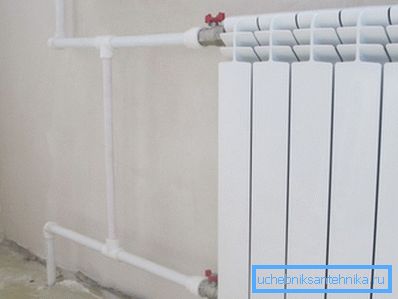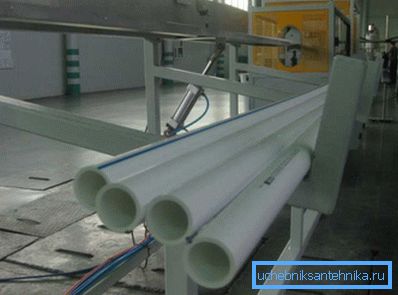Features of the choice and technical characteristics of
Pipelines created from polypropylene materials have long crossed the line between exotic and commonplace. Polypropylene has long been a leader among such kind of building materials due to its durability, reliability and availability, such a parameter as price. Are pipes of this type suitable for building heating systems? This is what we will now find out.

Propylene as part of heating systems

What is the fundamental difference between the materials used for heating circuits and pipes for cold water supply?
- The pressure parameters in the heating system are twice as large: 6 kgf / cm2 versus 3-3.5 kgf / cm2;
Note! If the house has a pumping system in cold water supply, then the pressure in this circuit can reach the same 6 kgf / cm2 and even more.
- According to the standards, the temperature of heating systems can reach 95-100 degrees;
- During the year, the coolant temperature of the system ranges from room to maximum. So, when creating a system, one should take into account such a parameter as linear expansion of polypropylene pipes.
Polypropylene features
Now we should consider the main characteristics of polypropylene pipes.
- The lowest density among known types of plastics is 0.91 kg / cm2. Despite its low density, the material is quite hard and resistant to abrasion. Using such pipes, you can not worry that the system will be quickly worn out under the influence of abrasive particles in the coolant;
- Mechanical strength is directly dependent on the speed of application of force.. If such a pipe is bent over quickly, it will simply burst, but if it is done slowly, the material will bend;
- High resistance to aggressive chemical attack. Exposure to high temperature concentrated acid may cause serious damage. This property is very important, since additives are often present in the coolant;
- Resistant to low temperatures;
- Polypropylene melting point 160-170 degrees;
- Softening threshold - 140 degrees;
- Maximum temperature operational parameter - 120 degrees;
- High coefficient of linear expansion of polypropylene pipes equal to 0.15 mm / m * s.
Note! Straight three-meter pipe from floor to ceiling will lengthen by 31.5 mm when heated from 20 to 90 degrees.
An extension of more than 3 cm will cause the pipe to arch out like a stretched bow.
Reinforcement

To solve the problem of thermal expansion, there is a simple but quite effective method - reinforcement. A material with low thermal expansion is used as a linear stabilizer. As a result of using this method, the expansion rate is reduced five times and becomes equal to - 0.003 mm / m * s.
Reinforcement of pipes produced by the following methods:
- Foil. The pipe, reinforced with foil, is a three-layer cake, where there is a thin layer of aluminum between the polypropylene. Such products are highly dependent on the quality of production, if not all the requirements of the technology are met, then the pipe will easily stratify;
- Fiberglass. Such products are monolithic material, since the fiber layer is located directly in the thickness of polypropylene. These pipes are not subject to delamination and they do not require a stripping process during installation.
Coolant temperature
At the time of heating of polypropylene pipes under the influence of the hot coolant there are several factors:
- Most popular manufacturers guarantee proper operation of systems at a temperature of 90-95 degrees;
- Temperature charts are relevant for the Russian climate, the upper limit of which is 95-105 degrees (achievable only in extreme frosts);
- In order to give the heating system a temperature of 95 degrees, the heat transfer medium in the supply pipe will be heated to 140 degrees.
In extreme situations, when Teplovik openly violates the schedule, due to complaints from numerous residents, a rather rude solution is practiced - the nozzle of the elevator assembly is simply pulled out and the suction of the system is jammed. In this case, the water will flow directly into the radiators of this temperature, which is simply dangerous for polypropylene.

The use of polypropylene in heating

From all of the above, we can draw the following conclusions about whether to use polypropylene in heating:
- Such pipes should not be used for heating in regions characterized by severe frosts;
- Only reinforced types of products should be used for heating and hot water supply, and both foil and fiberglass are equally applicable. Moreover, in the case of fiberglass, an instruction for a welded installation method can be implemented, and to assemble a pipeline of pipes reinforced with aluminum foil with your own hands, you will need a wiper;
- During installation, avoid installing pipes in a spacer between the wall and the ceiling. Always leave gaps for linear expansion.
Criterias of choice
Making a choice among the diversity of the modern market, special attention should be paid to the following points.
Pressure
In order to determine the working pressure of the product, pay attention to what is the marking of polypropylene pipes of the type PN **. The numbers indicated after these letters indicate the parameters of the working pressure in the atmospheres.

Note! The designation of polypropylene pipes indicates the operating pressure at a temperature of 20 degrees. For this reason, it should be divided into three and choose pipes PN25. In reality, PN20 pipes are massively used for heating circuits, and the owners do not know the problems.
Temperature
Marking usually contains data on the maximum operating temperature. Usually manufacturers indicate 90 or 95 degrees. For the consumer, these values are equivalent, and manufacturers, therefore, simply protect themselves from lawsuits to a greater or lesser extent.
dimensions

Often people are interested in, what is the length of polypropylene pipe? Manufacturers produce products with a length of 6m, everything else is considered cutting or waste.
In order to choose the diameter of such products, builders use complex construction formulas that take into account heat loads, temperature drops, roughness, etc.
The pipe diameter is subject to standardization. The minimum diameter size is 16 mm, and the maximum is 110 mm. But there are a number of pipes that are used for laying underground utilities with a diameter of up to 1200 mm.
Welding of polypropylene pipes
It is the welded diffusion bonding method that is considered the most popular for polypropylene products. This connection is associated with the interpenetration of straightened edges of products.
Council To implement this method of installation should use materials of the same material.
The durability of the joint is guaranteed by the physical properties of the material in the weld area.
- Before installation, cut into pieces of the required size strictly at right angles;
- Specialized welding machine is heated with the mode of soldering plastic pipes in 260 degrees;
- Before the start of welding, the pipe surface is cleaned and degreased with a solvent;
- If aluminum-reinforced material is used, the end of the pipe is cleaned with a special tool;
- After making the connection, both ends of the pipe should be fixed in one position for 4-8 minutes.
For the production of welding, the duration of heating products depends on the diameter of the products and the thickness of their walls. The welding time, weld width, and other parameters depend on the characteristics of the pipes. Therefore, before starting work, you should be familiar with the data provided by the heating table of polypropylene pipes.

Finally
All presented in this article and the considered technical characteristics of polypropylene materials make it easy to call these products among the most popular and sought after in the modern market. They become the best replacement for the usual metallic materials.
The video in this article will tell you even more parameters and characteristics of pipes from different types of polypropylene.